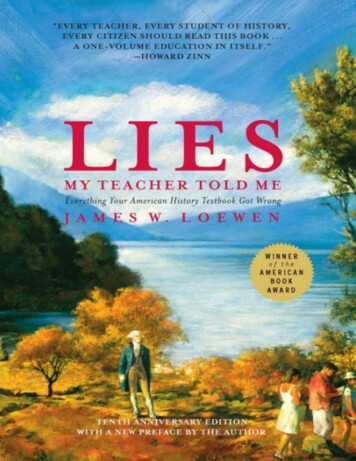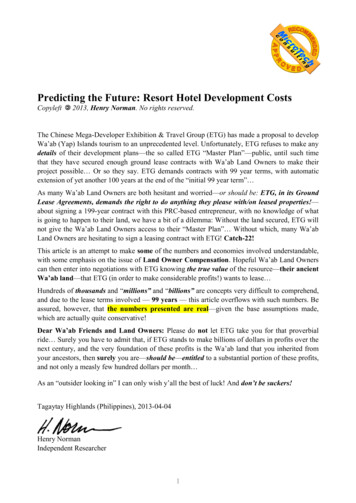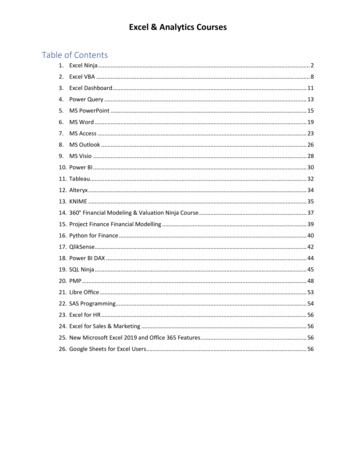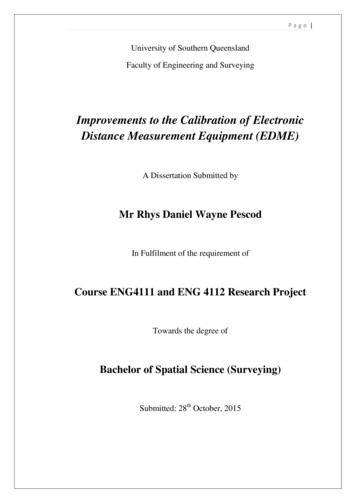
Transcription
Table of ContentsALSO BY JAMES W. LOEWENTitle TIONChapter 1. - HANDICAPPED BY HISTORYChapter 2. - 1493Chapter 3. - THE TRUTH ABOUT THE FIRST THANKSGIVINGChapter 4. - RED EYESChapter 5. - “GONE WITH THE WIND”Chapter 6. - JOHN BROWN AND ABRAHAM LINCOLNChapter 7. - THE LAND OF OPPORTUNITYChapter 8. - WATCHING BIG BROTHERChapter 9. - SEE NO EVILChapter 10. - DOWN THE MEMORY HOLE:Chapter 11. - PROGRESS IS OUR MOST IMPORTANT PRODUCTChapter 12. - WHY IS HISTORY TAUGHT LIKE THIS?Chapter 13. - WHAT IS THE RESULT OF TEACHING HISTORY LIKETHIS?AFTERWORDNOTESAPPENDIXINDEXCopyright Page
ALSO BY JAMES W. LOEWENLies Across America: What Our Historic Sites Get WrongLies My Teacher Told Me About Christopher ColumbusThe Mississippi Chinese: Between Black and WhiteMississippi: Conflict and Change (with Charles Sallis et al.)Rethinking Our Past: Recognizing Facts, Fiction, and Lies in American HistorySocial Science in the CourtroomSundown Towns:A Hidden Dimension of American Racism
Dedicated to all American history teacherswho teach against their textbooks(and their ranks are growing)
ACKNOWLEDGMENTSTO THE FIRST EDITIONTHE PEOPLE LISTED BELOW in alphabetical order talked with me,commented on chapters, suggested sources, corrected my mistakes, or providedother moral or material aid. I thank them very much. They are: Ken Ames,Charles Arnaude, Stephen Aron, James Baker, Jose Barreiro, Carol Berkin,Sanford Berman, Robert Bieder, Bill Bigelow, Michael Blakey, Linda Brew,Tim Brookes, Josh Brown, Lonnie Bunch, Vernon Burton, Claire Cuddy,Richard N. Current, Pete Daniel, Kevin Dann, Martha Day, Margo Del Vecchio,Susan Dixon, Ariel Dorfman, Mary Dyer, Shirley Engel, Bill Evans, JohnFadden, Patrick Ferguson, Paul Finkelman, Frances FitzGerald, WilliamFitzhugh, John Franklin, Michael Frisch, Mel Gabler, James Gardiner, JohnGarraty, Elise Guyette, Mary E. Haas, Patrick Hagopian, William Haviland,Gordon Henderson, Mark Hilgendorf, Richard Hill, Mark Hirsch, Dean Hoge, JoHoge, Jeanne Houck, Frederick Hoxie, David Hutchinson, Carolyn Jackson,Clifton H. Johnson, Elizabeth Judge, Stuart Kaufman, David Kelley, RogerKennedy, Paul Kleppner, J. Morgan Kousser, Gary Kulik, Jill Laramie, KenLawrence, Mary Lehman, Steve Lewin, Garet Livermore, Lucy Loewen, NickLoewen, Barbara M. Loste, Mark Lytle, John Marciano, J. Dan Marshall, JuanMauro, Edith Mayo, James McPherson, Dennis Meadows, Donella Meadows,Dennis Medina, Betty Meggars, Milton Meltzer, Deborah Menkart, DonnaMorgenstern, Nanepashemet, Janet Noble, Roger Norland, Jeff Nygaard, JimO’Brien, Wardell Payne, Mark Pendergrast, Larry Pizer, Bernice Reagon, EllenReeves, Joe Reidy, Roy Rozensweig, Harry Rubenstein, Faith Davis Ruffins,John Salter, Saul Schniderman, Barry Schwartz, John Anthony Scott, LouisSegal, Ruth Selig, Betty Sharpe, Brian Sherman, David Shiman, Beatrice Siegel,Barbara Clark Smith, Luther Spoehr, Jerold Starr, Mark Stoler, Bill Sturtevant,Lonn Taylor, Linda Tucker, Harriet Tyson, Ivan Van Sertima, Herman Viola,Virgil J. Vogel, Debbie Warner, Barbara Woods, Nancy Wright, and JohnYewell.
Three institutions helped materially. The Smithsonian Institution awarded metwo senior postdoctoral fellowships. Members of its staff provided livelyintellectual stimulation, as did my fellow fellows at the National Museum ofAmerican History. Interns at the Smithsonian from the University of Michigan,Johns Hopkins, and especially Portland State University chased down errantfacts. The flexible University of Vermont allowed me to go on leave to work onthis book, including a sabbatical leave in 1993. Finally, The New Press, AndréSchiffrin, and especially my editor, Diane Wachtell, provided consistentencouragement and intelligent criticism.TO THE SECOND EDITIONAS I ENDURED THE MORAL and intellectual torture of subjecting myself tosix new high school American history textbooks in 2006-07, the followingassisted in important ways: Cindy King, David Luchs, Susan Luchs, NatalieMartin, Jyothi Natarajan, the Life Cycle Institute and Department of Sociologyat Catholic University of America, and Joey the guide dog in training. Many ofthe folks thanked for their assistance with the first edition—including those atThe New Press—also helped this time. So did Amanda Patten at Simon &Schuster.
INTRODUCTIONTO THE SECOND EDITIONI really like your book, Lies My Teacher Told Me. I’ve beenusing it to heckle my history teacher from the back of the room.—HIGH SCHOOL STUDENT1I just wanted to let you know that I don’t consider Lies MyTeacher Told Me outdated; I really don’t see much improvementin textbooks at all!—HIGH SCHOOL TEACHER, SHERWOOD, AR2I was expecting some liberal bullshit, but I thought it was righton.—WORKER, BAYER PHARMACEUTICALS, BERKELEY, CA3READERS NEW TO Lies My Teacher Told Me should go straight to page one.This introduction tells old friends (and enemies?) how this edition differs fromthe first and why it came to be. Since it came to be largely because readerresponse to the first edition was so positive, the introduction seems selfcongratulatory to me—another reason to skip it. Lies My Teacher Told Me doestake readers on a voyage of discovery through our past, however, and somereaders may want to learn of the reactions of fellow passengers.From the first day, readers made Lies a success. As its name implies, The NewPress was a small fledgling publisher without an advertising budget; word of
mouth caused Lies to sell. The book first created a stir on the West Coast.“Although the book is considered controversial by some, libraries in AlamedaCounty [California] can’t keep it on their shelves,” reported an article atCalifornia State University at Hayward. A high school student wrote to theeditor of the San Francisco Examiner: “I was a poor (D-plus) student in historyuntil I read People’s History of the United States and Lies My Teacher Told Me.After reading those two books, my GPA in history rose to 3.8 and stayed there.If you truly want students to take an interest in American history, then stop lyingto them.” 4 An early review in the San Francisco Chronicle called Lies “anextremely convincing plea for truth in education,” and my book spent severalweeks on the Bay Area bestseller list in 1995.5Independent bookstores—the kind whose owners and clerks read books andwhose customers ask them for recommendations—spread the buzz across NorthAmerica. “Turns American history upside down,” wrote “Joan” of Toronto in1995 in a column called “Best New Books Recommended by LeadingIndependent Bookstores.” “A landmark book,” she went on, “a must read, notonly for teachers of history and those who write it, but for any thinkingindividual.” 6 The Nation, a national magazine, said that Lies “contains so muchhistory that it ends up functioning not just as a critique but also as a kind ofcounter-textbook that retells the story of the American past.” Soon Lies reachedthe bestseller lists in Boston; Burlington, Vermont; and other cities. It was also abestseller for the History and Quality Paperback Book Clubs. In paperback, Lieshas gone through more than thirty printings at Simon & Schuster. From thelaunch of Amazon.com, Lies has been the sales leader in its category(historiography). So, as far as I can tell, Lies is the bestselling book by a livingsociologist.7 Counting all editions, including Recorded Books, sales of the firstedition totaled about a million copies.I wrote Lies My Teacher Told Me partly because I believed that Americanstook great interest in their past but had been bored to tears by their high schoolAmerican history courses. Readers’ reactions confirmed this belief. Theirresponses were not only wide, but deep. “My history classes in high school, Ifound, were not important to me or my life,” e-mailed one reader from the SanFrancisco area, because they “did not make it relevant to what was happeningtoday.” Some adult readers had always blamed themselves for their lack ofinterest in high school history. “For all these years (I am forty-nine), I have hadthe opinion that I don’t like history,” wrote a woman from Utah, “when in truth,
what I don’t like is illogic, or inconsistency. Thank you for your work. You havechanged my life.”Many readers found the book to be a life-changing experience. A forkliftoperator in Ohio, a forty-seven-year-old housewife in Denver, a “do-gooder” inupstate New York were inspired to finish college or graduate school and changecareers by reading this book. “Words cannot describe how much your book haschanged me,” wrote a woman from New York City. “It’s like seeing everythingthrough new eyes. The eyes of truth as I like to call it.” While readers repeatadjectives like “shocked,” “stunned,” and “disillusioned,” many have also foundLies to be uplifting.To be sure, not every reaction was positive. Although one reader “never coulddecide whether you were a Socialist or a Republican,” others thought they couldand that Lies suffers from a leftward bias. “Marxist/hippie/socialist/ antiAmerican/anti-Christian” commented one reader at Amazon.com, who would beshocked to learn my real feelings about capitalism. “What a piece of racisttrash,” said an anonymous postcard from El Paso. “Take your sour mind toAfrica where you can adjust that history.”That was, of course, a white response—a very white response. Very differenthas been the reaction from “Indian country.” A reader who I infer is part-Indianwrote:Your book Lies My Teacher Told Me, and especially the chapter “RedEyes,” has had an unprecedented effect on how I view the world. I havenever felt inclined to write a letter of approval for anything I’ve readbefore. Your description of the Indian experience in the United Statesand, more importantly, the concept of a syncretic American society hassubtly, but powerfully, changed my understanding of my country, and, infact, my own ancestry.If, as Lies My Teacher Told Me shows, history is the least-liked subject inAmerican high schools, it is positively abhorred in Indian country. There it is therecord of five centuries of defeat. Yet, properly understood, American history isnot a record of Native incompetence but of survival and perseverance. Fromspeaking before Native audiences in six states, I have come to understand towhat extent false history holds Native Americans down. I now believe that onlywhen they accurately understand their past—including their recent past—willyoung American Indians find the social and intellectual power to make history in
the twenty-first century. That understanding must include the concept ofsyncretism—blending elements from two different cultures to come up withsomething new. Syncretism is how cultures typically change and survive, and allAmericans need to understand that Native American cultures, too, must changeto survive. Natives as well as non-Natives often labor under the misapprehensionthat “real” Indian culture was those practices that existed before white contact.Actually, real Indian culture is still being produced—by sculptors like NalenikTemela (page 133), musicians like Keith Secola, and American Indian parentseverywhere.Lies has also enjoyed huge success among African Americans. In the fall of2004, for example, it reached number three on the bestseller list of Essencemagazine and was the only book on that list by a nonblack author. “My students,who are all African Americans, were immensely enthused and energized by yourbook,” wrote a sociology professor at Hampton University. A Missouri nativewrote that he found Lies My Teacher Told Me and Lies Across America“incredibly empowering” and planned “to buy an extra copy of both books andleave them in the barbershop I patronize in downtown St. Louis. I figure if oneor two kids read it, it will make a huge difference for generations to come.”Working-class groups and labor historians have also enjoyed Lies. “Thanksagain for your scholarship and solidarity in helping show the side of the storythat best reflects the roots of the other 90 percent who aren’t wealthy,” wrote anonwealthy reader in 2004. Programs in gay and lesbian studies and women’sstudies have also invited me to speak, even though Lies My Teacher Told Me—unlike its successor Lies Across America—contains no explicit treatment ofsexual identity or preference or gender issues.8 Prisoners respond positively, too:a Wisconsin inmate, for example, wrote, “My congratulations to you for thecourage you had to have to write such a book that goes against the grain.”Hardly least, “regular” white folks—even males—like my book, too, perhapsbecause I take obvious satisfaction in and give credit to those white men fromBartolomé de Las Casas through Robert Flournoy to Mississippi judge OrmaSmith who have fought for justice for all of us.If Lies My Teacher Told Me has made such an impact, why this new edition?Especially when the book, as of 2007, was selling better than ever, averagingnearly two thousand copies per week?Back in 2003, writing from Walnut Creek, California, a devoted reader
convinced me of the need for a new edition. “I think many people believe thatyour book describes problems that USED TO exist in school textbooks, not ascurrent problems,” she e-mailed me. “My own anecdotal experience with myown kids’ school textbooks is that many of your original findings remain valid.An updated edition would make it harder for people to minimize your book’struth by characterizing it as dated.” Questions from audiences over the yearstaught me that despite my debunking of automatic progress in Chapter 11, manyreaders still believe in the myth, even as applied to the textbook publishingindustry. The problems I noted with high school history books were so gallingthat these readers want to believe—and therefore do believe—that the booksmust have improved. Unfortunately, we cannot assume progress. Whetherhistory textbooks have improved is an empirical question. It can only beanswered with data. And it is an interesting question, especially to me, because itsubsumes another query: Did my book make any difference?So I spent much of 2006-07 pondering six new U.S. history textbooks. I didfind them improved in a few regards—especially in their treatment ofChristopher Columbus and the ensuing Columbian Exchange. I also found themworse or unchanged in many other regards—but that is the subject of the rest ofthe book. It’s safe to conclude that Lies didn’t influence textbook publishers verymuch. This did not surprise me, because fifteen years earlier, FrancesFitzGerald’s critique of textbooks, America Revised, was also a bestseller, but it,too, made little impact on the industry.However, Lies did reach and move teachers. Doing so is important, becauseone teacher can reach a hundred students, and another hundred next year.Teachers were a central audience I had in mind as I wrote Lies. What have theymade of it?Sadly, a few teachers rejected Lies unread, concluding from its title that I amone more teacher-basher. The book itself never bashes teachers. As a formercollege professor who in a typical semester appeared before students for ninehours a week, I have great respect for K-12 teachers. Many work in classroomsfor as many as thirty-five hours a week; on top of that they must assign, read,and comment on homework, prepare and grade exams, and develop next week’slesson plans. When are they supposed to find time to research what they teach inAmerican history? During their unpaid summers and weekends? Moreover, Irealize that a sizable proportion—I used to estimate 25 to 30 percent, but thenumber is growing—of high school American history teachers are serious about
their subject. They study it themselves and get their students involved in doinghistory and critiquing their textbooks. In speeches to teacher groups, I used tobegin by acknowledging all the foregoing, trying to persuade them to venturebeyond the book’s title.9 Moreover, there is a certain tension between the titleand the subtitle, “Everything Your American History Textbook Got Wrong.” Ifteachers merely rely on their textbooks, however, and try to get students to“learn” them, and if the textbooks are as bad as the next eleven chapters suggest,then teachers are complicit in miseducating their charges about our past.In central Illinois, a teacher provided an example of what to do about badtextbooks. In autumn 2003, treating the early years of the republic, she told hersixth graders in passing that most presidents before Lincoln were slave owners.Her students were outraged—not with the presidents, but with her, for lying tothem. “That’s not true,” they protested, “or it would be in the book!” Theypointed out that the book devoted many pages to Washington, Jefferson,Madison, Jackson, and other early presidents, pages that said not one word abouttheir owning slaves. “Maybe I’m wrong, then,” she replied, suggesting that theycheck her facts. Each chose a president and found out about him. When theyregrouped, they were outraged at their textbook for denying them thisinformation. They wrote letters to the putative author and the publisher. Theauthor never replied, which did not surprise me—as we shall see, many authorsnever wrote “their” textbooks, especially in their later editions. Some are evendeceased. The students did get a reply from a spokesperson at the publisher. “Weare always glad to get feedback on our product,” it went, or boilerplate to thateffect. Then it suggested, “If you will look at pages 501-506, you will findsubstantial treatment of the Civil Rights Movement.” The students looked ateach other blankly: how did this relate to their complaint?Such a critique is a win-win action for students. Either they improve thetextbook for the next generation of students, or they learn that a vacuum residesat the intellectual center of the textbook establishment. Either way, they becomecritical readers for the rest of the academic year.The story of these sixth graders shows that we underestimate children at ourperil. Teachers who have gotten students as young as fourth grade to challengetextbooks and do original research have found that they exceeded expectations.A fifth-grade teacher in far southwestern Virginia wrote me that at the start ofthe year his students say they hate history. “Within two weeks, all or most lovehistory.” He gets them involved with:
primary source documents such as newspaper accounts and actual photosof freedmen being lynched. This is tough on the kids sometimes but theyhandle it well. They get an attitude about evil and vow to keep it fromhappening. They no longer think that video games with people gettingblown up are funny. They even start to check out books on history andread them and get away from the sanitized vanilla yogurt in the textbooksand shoot for a five-alarm chili type of history. They love history that has“the good stuff ” in it. And then they are promoted and go back to thetextbook! Which creates a problem. They raise hell with the next teacher!They become politically active within the middle school. They look likethey will become good citizens.Surely good citizens are what we want—but what do we mean by a “goodcitizen”? Educators first required American history as a high school subject aspart of a nationalist flag-waving campaign around 1900. Its nationalistic genesishas always interfered with its basic mission: to prepare students to do their job asAmericans.Again, what exactly is our job as Americans? Surely it is to bring into beingthe America of the future. What should characterize that nation? How should itbalance civil liberties and surveillance against potential terrorists? Should itallow gay marriage? What should its energy policies be, as the world’s finitesupply of oil begins to impact upon us? To participate in these discussions andinfluence these debates, good citizens need to be able to evaluate the claims thatour leaders and would-be leaders make. They must read critically, winnow factfrom fraud, and seek to understand causes and results in the past. These skillsmust stand at the center of any competent history course.These are not skills that American history textbooks foster—even the recentones. Nor do courses based on them. Why then do teachers put up with suchbooks? The answer: they make their busy lives easier. The teachers’ edition ofHolt American Nation, to take one example, begins with twenty-two pages ofads making this point. One page touts its “Management System.” It contrasts twophotographs. One shows a teacher struggling to carry a textbook, several otherbooks, some overhead projections, a binder of lecture notes, and miscellaneouspapers, the other a teacher smiling as she slips a single CD into her purse.“Everything you need is on one disk!” trumpets the ad, including “editablelesson plans,” “classroom presentations” containing lecture notes suitable forprojection, and an “easy-to-use test generator.” No longer do teachers need to
make their own lesson plans or construct their own tests, and if they run out ofthings to say in the classroom, the disk also contains previews of the teachingresources and movies that Holt offers as ancillary materials. Many of thesesupplements, including a series of CNN videos, are more valuable educationtools than the textbook itself. The problem is that the purpose of all theancillaries is to get teachers to adopt Holt’s textbook. Then, since the textbookruns to 1,240 pages—and all too many teachers assign them all—students areunlikely to have time to do anything with any of these additional materials.Sometimes help comes from the top down. Many school systems have growndispleased with the low student morale in these textbook-driven history courses.As a matter of school-board policy, at least two systems require any teacher insocial studies or history to read my book. Homeschoolers have also found theirway to Lies My Teacher Told Me. Wrote David Stanton, editor of a resourcecatalog for homeschoolers, “I read it cover to cover (including the footnotes),found it hard to put down, and was sad when it ended.”Students have also taken matters into their own hands. A fourteen-year-old inMount Vernon, South Dakota, going into the ninth grade, had already read LiesMy Teacher Told Me and Lies Across America. “These are EXCELLENTbooks!” she wrote. “After reading them, I spread them around the school todifferent teachers. All were shocked and, due to this, are changing their teachingmethods.” John Jennings, a high school student somewhere in cyberspace, wrotethat he and a group of his friends “have read your book Lies My Teacher ToldMe and it has opened our eyes to the true history behind our country, positiveand negative.” He went on to add that he is “signed up to take American Historynext semester . . . and we are using one of the twelve textbooks you reviewed, soI can’t wait to attempt to start discussions in class concerning issues discussed inyour book and use your book as a reference.” A North Carolina dad wrote, “Mydaughter uses Lies My Teacher Told Me as a guerrilla text in her grade elevenAdvanced Placement U.S. History, and loves it—although the teacher isn’talways as pleased.” My favorite e-mail of all came in from a lad somewhere atAOL.com: “Dear Mr. Loewen, I really like your book, Lies My Teacher ToldMe. I’ve been using it to heckle my history teacher from the back of the room.”My friends all like it, too, he went on. “If I could get a group price on it from thepublisher, I could sell it in the corridors of my high school.” I got him the groupprice, and since then, several teachers—perhaps including his—have told methat my book, in the hands of precocious pupils, made their lives miserable until
they got their own copy, which jarred them out of their textbook rut. So there isalso hope from the bottom up.Best of all has been the response in the “aftermarket”—adults who haveturned to Lies because they sensed something remiss about their boring highschool history courses. Many find it a book to share. “I read it twice and then itmade the round of friends who were stubborn about returning it, but I finally gotit back and now I’m reading it again,” wrote a security guard in California.“After completing each successive chapter, I always felt that I had to commentto a friend about what I just learned,” wrote a graduate-student-to-be ineducation. “I have been sharing your information with every teacher I can get tostand still for five minutes,” wrote a teacher’s aide in Montana. “This is a bookthat you buy two of,” wrote a professor in New Hampshire, “one to read andkeep, and one to lend or give away.” A reader in Sherman Oaks, California, said,“It is more than just interesting: it is life-enriching. I will give copies as gifts . . .for years to come.” Some readers get them cheap: they join the QualityPaperback Book Club to obtain four copies of Lies for a dollar each, give themto four friends, quit the club, then join again to get four more.10I hope you find this new edition of Lies as useful as the first in getting people toquestion what they think they know about American history. If you do, share itwith others. No doubt the publisher would like to sell everyone you know acopy, but I’m happiest when Lies gets multiple readers. I’m also happy to getreaders’ reactions—positive or negative11—to my work. You can reach methrough my website, uvm.edu/ jloewen/, or jloewen@uvm.edu.
INTRODUCTIONSOMETHING HAS GONE VERY WRONGIt would be better not to know so many things than to know somany things that are not so.—JOSH BILLINGS1American history is longer, larger, more various, more beautiful,and more terrible than anything anyone has ever said about it.—JAMES BALDWIN2Concealment of the historical truth is a crime against the people.—GEN. PETRO G. GRIGORENKO, SAMIZDAT LETTER TO A HISTORYJOURNAL, c. 1975, USSR3Those who don’t remember the past are condemned to repeat theeleventh grade.—JAMES W . LOEWENHIGH SCHOOL STUDENTS hate history. When they list their favoritesubjects, history invariably comes in last. Students consider history “the mostirrelevant” of twenty-one subjects commonly taught in high school. Bor-r-ring isthe adjective they apply to it. When students can, they avoid it, even thoughmost students get higher grades in history than in math, science, or English.4
Even when they are forced to take classes in history, they repress what theylearn, so every year or two another study decries what our seventeen-year-oldsdon’t know.5Even male children of affluent white families think that history as taught inhigh school is “too neat and rosy.” 6 African American, Native American, andLatino students view history with a special dislike. They also learn historyespecially poorly. Students of color do only slightly worse than white students inmathematics. If you’ll pardon my grammar, nonwhite students do more worse inEnglish and most worse in history.7 Something intriguing is going on here:surely history is not more difficult for minorities than trigonometry or Faulkner.Students don’t even know they are alienated, only that they “don’t like socialstudies” or “aren’t any good at history.” In college, most students of color givehistory departments a wide berth.Many history teachers perceive the low morale in their classrooms. If theyhave a lot of time, light domestic responsibilities, sufficient resources, and aflexible principal, some teachers respond by abandoning the overstuffedtextbooks and reinventing their American history courses. All too many teachersgrow disheartened and settle for less. At least dimly aware that their students arenot requiting their own love of history, these teachers withdraw some of theirenergy from their courses. Gradually they end up going through the motions,staying ahead of their students in the textbooks, covering only material that willappear on the next test.College teachers in most disciplines are happy when their students have hadsignificant exposure to the subject before college. Not teachers in history.History professors in college routinely put down high school history courses. Acolleague of mine calls his survey of American history “Iconoclasm I and II,”because he sees his job as disabusing his charges of what they learned in highschool to make room for more accurate information. In no other field does thishappen. Mathematics professors, for instance, know that non-Euclideangeometry is rarely taught in high school, but they don’t assume that Euclideangeometry was mistaught. Professors of English literature don’t presume thatRomeo and Juliet was misunderstood in high school. Indeed, history is the onlyfield in which the more courses students take, the stupider they become.Perhaps I do not need to convince you that American history is important.More than any other topic, it is about us. Whether one deems our present society
wondrous or awful or both, history reveals how we arrived at this point.Understanding our past is central to our ability to understand ourselves and theworld around us. We need to know our history, and according to sociologist C.Wright Mills, we know we do.8Outside of school, Americans show great interest in history. Historical novels,whether by Gore Vidal (Lincoln, Burr, et al.) or Dana Fuller Ross (Idaho!,Utah!, Nebraska!, Oregon!, Missouri!, and on! and on!) often becomebestsellers. The National Museum of American History is one of the three bigdraws of the Smithsonian Institution. The series The Civil War attracted newaudiences to public television. Movies based on historical incidents or themesare a continuing source of fascination, from Birth of a Nation through Gone Withthe Wind to Dances with Wolves, JFK, and Saving Private Ryan. Not historyitself but traditional American history courses turn students off.Our situation is this: American history is full of fantastic and importantstories. These stories have the power to spellbind audiences, even audiences ofdifficult seventh
launch of Amazon.com, Lies has been the sales leader in its category (historiography). So, as far as I can tell, Lies is the bestselling book by a living sociologist.7 Counting all editions, including Recorded Books, sales of the first edition totaled about a million copies. I wrote Lies My










